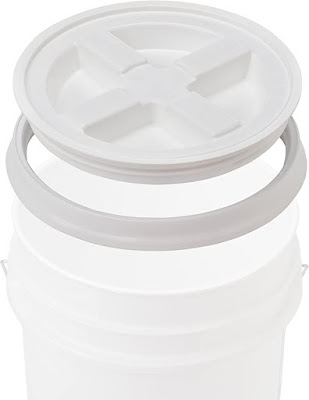This year we are dyeing with indigo, a historical dye that has been used for thousands of years by many cultures around the world. Dyeing with indigo is quite different from our previous dye projects. The reduction and fermentation processes required for natural indigo dyeing makes it more akin to wine making than extracting dye with heat. Part of the fun of a new project is figuring out the supplies that you need and "tooling up" in preparation.
Dye Kit
I decided to take the easy route for my first go at dyeing with indigo and plan to use the Jacquard Indigo Tie Dye Kit (Natural Dye Method). The kit includes everything I need to mix the dye vat. The indigo has been pre-reduced, so will be much easier to work with. The Jacquard Indigo Tie Dye Kit (Natural Dye Method) contains:
- Water-soluble, pre-reduced Indigo dye crystals
- Soda ash – fixer that raises the pH level and helps fabric better absorb dye
- Sodium hydrosulfite – reducing agent that converts indigo pigment into a water-soluble form
- Latex gloves
- Supplies for resist dyeing, such as tiles, and rubber bands in two sizes
- Instruction manuals
 |
| Jacquard Indigo Tie Dye Kit (Natural Dye Method) |
 |
| The kit contains everything needed to dye with indigo |
I’m content to use the water-soluble, pre-reduced indigo dye crystals to create the dye bath, rather than tackle the whole reducing and fermenting process. I prefer to experiment with different resist techniques such as Shibori, Batik, and tie-dye. Once mixed, the dye will keep for up to several weeks if sealed properly, and will dye 15 yards or 5 pounds of fabric, or 15 shirts.
Dye Vat
Unlike our previous experiences, the indigo dye vat can be kept sealed and the dye used when desired. There is no heating or keeping the dye at a particular temperature with indigo, as there is with other plant dyes we’ve used. It is important to seal the dye from the air, to keep it from oxidizing as much as possible. This 5-gallon bucket with a sealable lid should provide the seal and storage space needed for our dye vat.
 |
| Five-gallon bucket with sealable lid (Source: Amazon) |
Other supplies include:
- 36-inch-long paddle for stirring the vat (or similar)
- Rubber gloves to protect hands (the dye is not toxic so not required)
- Tray for placing dye objects as they transform from yellow-green to blue (I'm using a box lined with a garbage bag)
- Drop cloths to protect the work area
 |
| Long paddle for stirring the dye and removing oxidized dye (Source: WebstaurantStore) |
Resist Dyeing
The Indigo Tie Dye kit includes supplies for both Shibori and tie dyeing. Both are resist-dyeing techniques, where the dye is blocked from reaching the fiber, so the fabric is not dyed where blocked. The Shibori supplies include:
- Tiles in various sizes and shapes (the kit includes some wood tiles, and I purchased additional acrylic tiles in various sizes)
- Large and small rubber bands or clips
 |
| Additional acrylic tiles for shibori dyeing (Source: Amazon) |
I procured tiles in additional sizes and shapes. I’m looking forward to using folding techniques and tiles of various shapes and sizes to produce patterns, and using the rubber bands tie dyeing.
I’d also like to try another resist dyeing technique – Batik. Batik is traditionally done with wax, but I decided not to invest in any specialized equipment. Instead I plan to use common household items that are easy to obtain. Washable glue sounded like a practical and clever alternative to wax.
 |
| Washable glue as an alternative to wax |
Fabric
For fabric, I’ve replenished my cotton dish towel stash, and I’m using what I already have (cotton, linen, silk and wool). With indigo, there is no need to mordant fabric, but it is still important to scour the fabric to remove any coatings or impurities that might prevent dyeing. You can use the hot water or overnight soak techniques [see Scouring your Fabric and Scouring your Fabric (Soaking Method)].
 |
| Cotton dish towels (Source: Amazon) |
 |
| Fabric collected for previous dye projects |
If there is time and enough dye, I might try overdyeing to see what colors would be produced. I have dish towels that were previously dyed with weld and cochineal. (Do you suppose a dip in the indigo dye vat will produce green and navy)?
 |
| Possible overdye experiment with weld |
 |
| Another possible overdye experiment with cochineal |
I’m looking forward to working with indigo dye and seeing for myself the magical transformation process from yellow-green to blue. As usual, I have lots of ideas and plans, but may run out of time or dye strength. Whatever I decide to do, I’m tooled up and ready to dye!
Learn More
- Indigo - A World of Blue, by Maiwa Productions (2008).
- Maiwa How to Dye with Indigo (A World of Blue) – downloadable.
- DIY Shibori Tie Dye Techniques Tutorial (For Beginners), by Sarah Johnson.
- Glue Resist with Indigo and Washable Glue, by Katherine Rual. Onyx Art Studios.
No comments:
Post a Comment